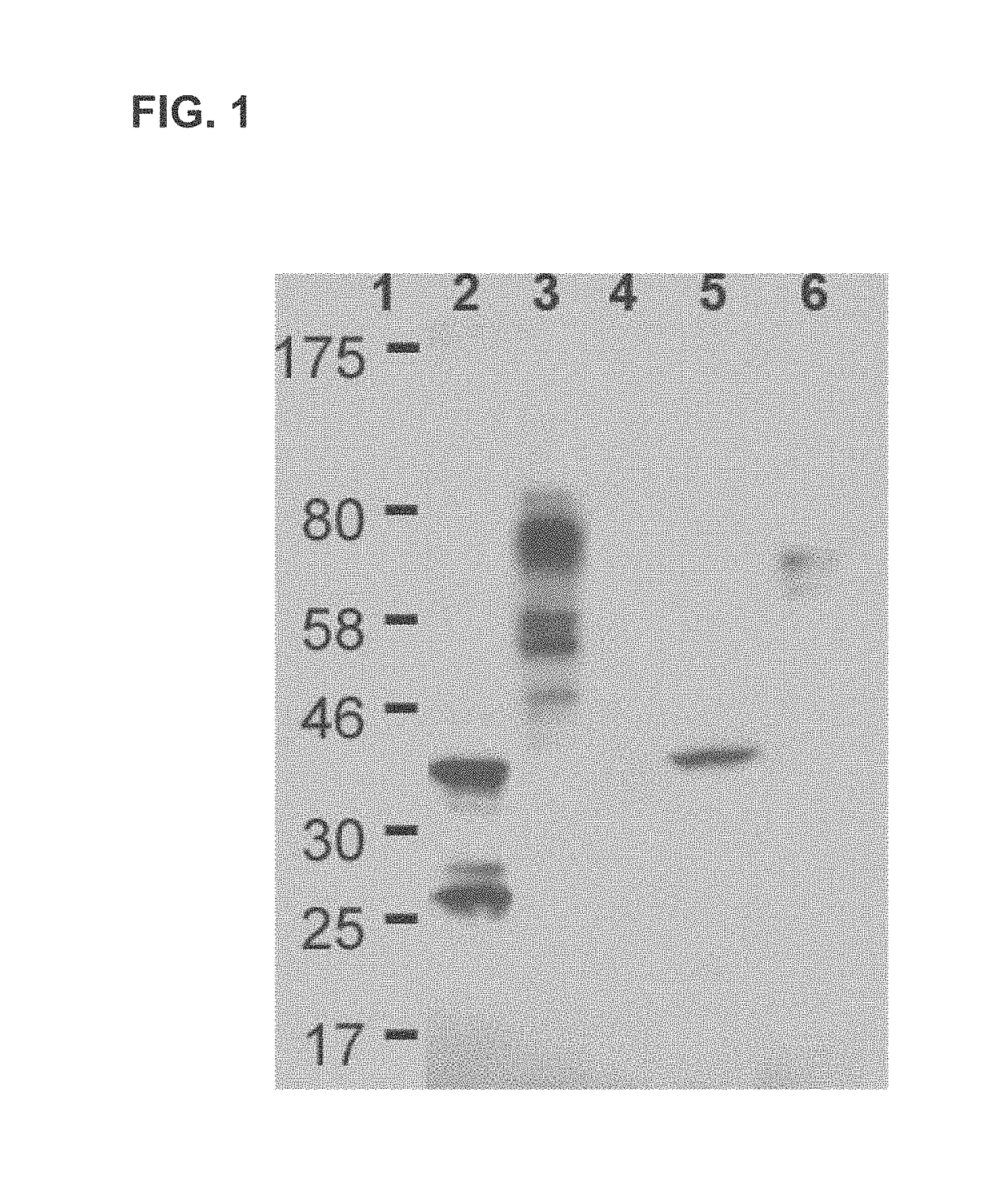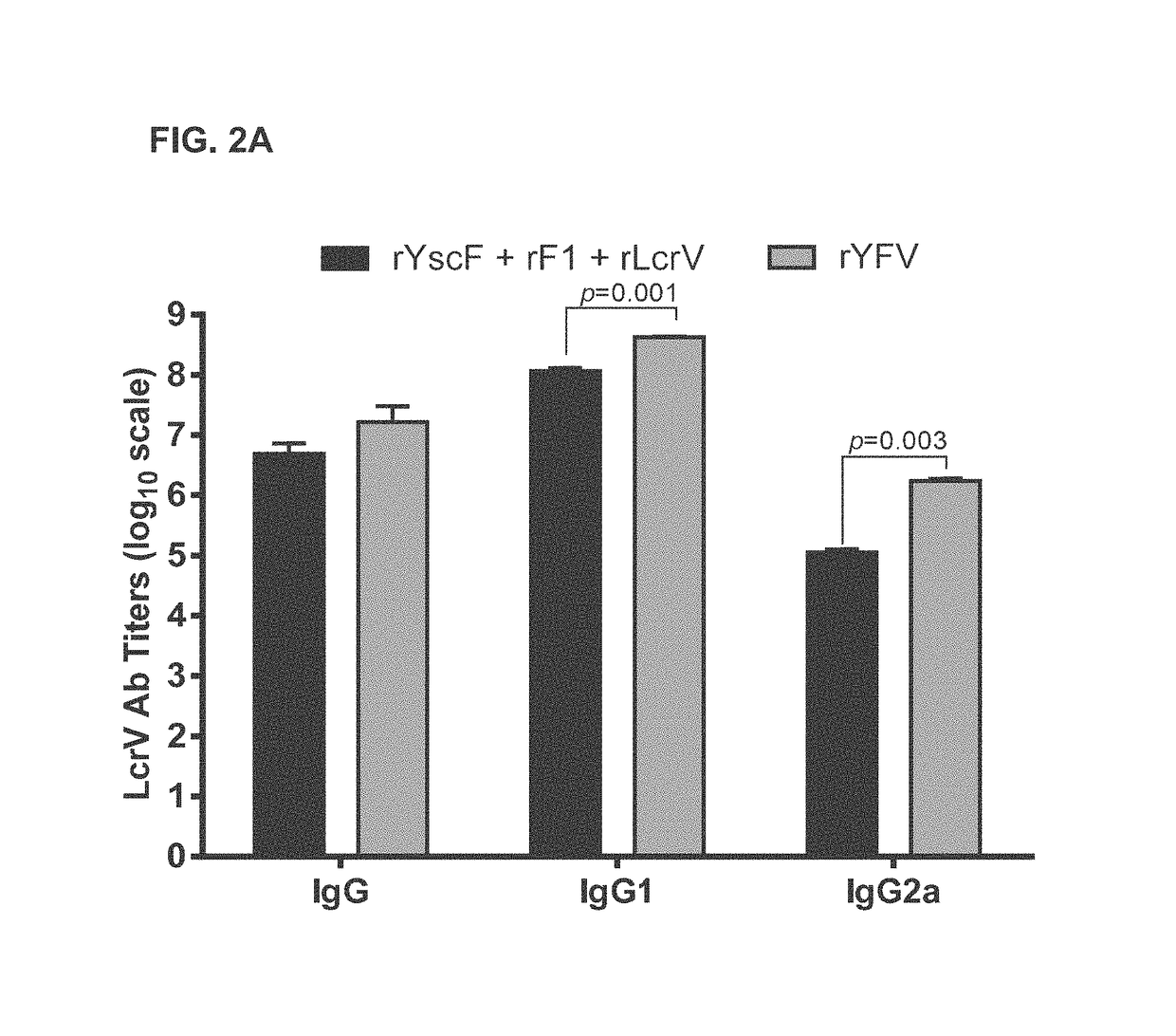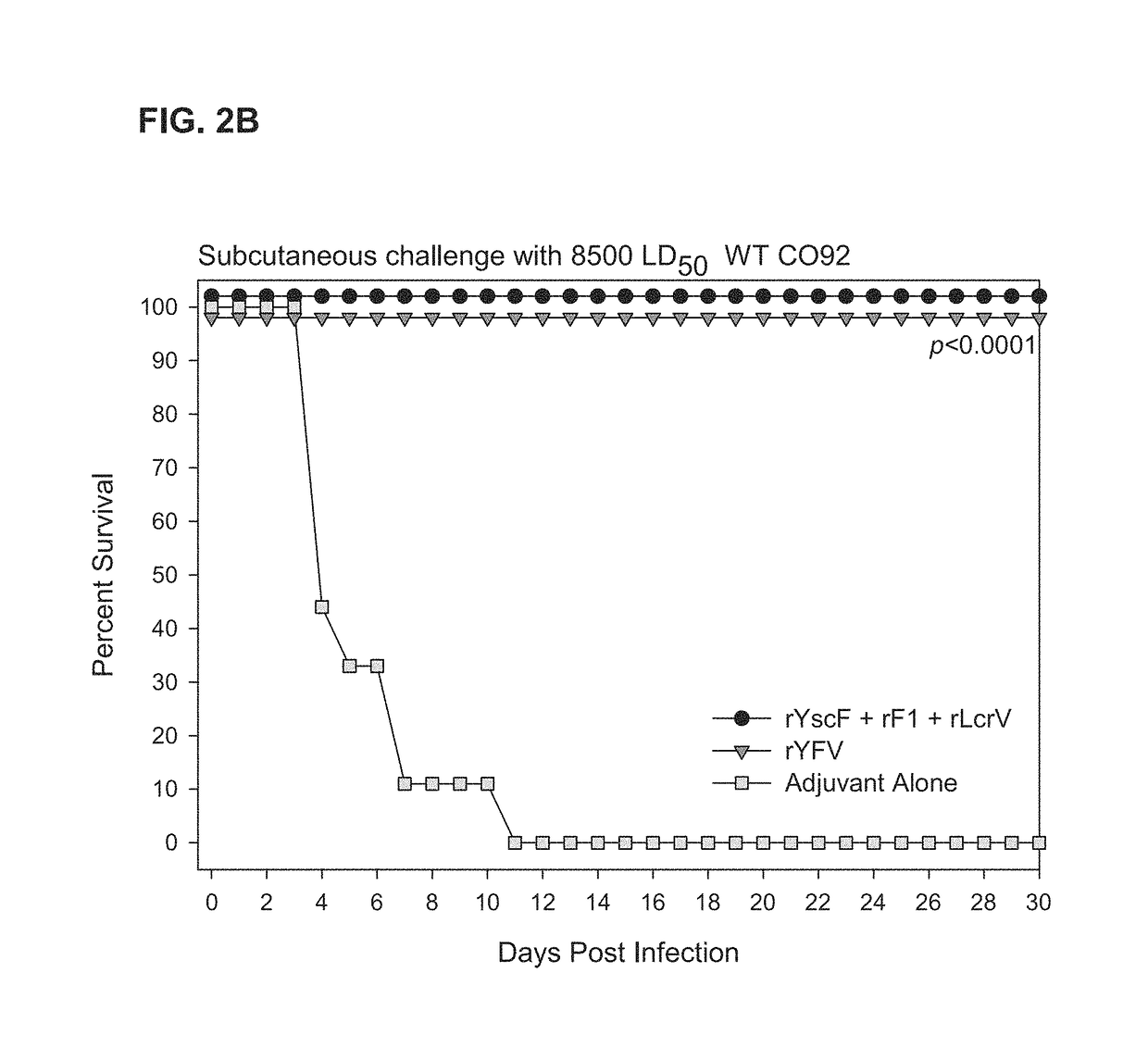However, considering the natural existence of fully virulent F1 minus Y. pestis strains (18, 19) or those that have highly diverged LcrV variants (20, 21), such F1-V-based vaccines would most likely not provide optimal protection across all plague-causing Y. pestis strains in humans.
However, the overall protection rate did not reach 100% in the pneumonic plague model (FIGS. 3B and 4B).
The vaccine was effective against bubonic plague, but protection against pneumonic plague was uncertain.
The incidence of side effects, such as
malaise,
headaches, elevated body temperature, and lymphadenopathy was high; and the vaccine was expensive (40).
However, the EV76-based vaccines are not genetically uniform and are also highly reactogenic (41), and, hence, would not meet the standards for
FDA approval.
The major problems encountered in developing live-attenuated vaccines are inadequate attenuation, particularly in immunocompromised individuals, and the potential to revert back to the virulent
phenotype.
In our initial study, a rAd5 expressing the Igk
secretion signal fused to YFV was successfully created; however, we found that the secreted YFV (sYFV) was toxic to HEK 293 cells, which prevented large-scale expansion of this construct (data not shown).
While some groups have reported favorable results with this approach, it offers only a short-term solution, as new adenoviral vector
adaptation will result in the generation of neutralizing antibodies through widespread use.
However, YopD-
vaccination provided protection only against the non-encapsulated
bacilli but not against the encapsulated Y. pestis CO92 strain.
Current challenges in the development of vaccines for pneumonic plague.
6.50. Bessis N, GarciaCozar F J, Boissier M C. 2004. Immune responses to
gene therapy vectors: influence on vector function and
effector mechanisms.
Gene Ther 11 Suppl 1:S10-17.<li class="uspto-
list-i
51. Molinier-Frenkel V, Lengagne R, Gaden F, Hong S S, Choppin J, Gahery-Segard H, Boulanger P, Guillet J G. 2002. Adenovirus
hexon protein is a potent
adjuvant for activation of a cellular immune response. J Virol 76:12.52. Hackett N R, Kaminsky S M, Sondhi D,
Crystal R G. 2000. Antivector and antitransgene host responses in
gene therapy. Curr Opin Mol T:376-382.53. Song W, Kong H L, Traktman P,
Crystal R G. 1997. Cytotoxic
T lymphocyte responses to proteins encoded by
heterologous transgenes transferrenoviral vectors.
Hum Gene Ther 8:1207-1217.54. Wilson J M. 1996. Adenoviruses as
gene-delivery vehicles. N Engl J Med 185-1187.55. Tripathy S K, Black H B, Goldwasser E, Leiden J M. 1996. Immune responses to
transgene-encoded proteins limit the stability of
gene expression after injection of replication-defective adenovirus vectors. ed 2:545-550.56. Lathem W W, Crosby S D, Miller V L, Goldman W E. 2005. Progression of primary pneumonic plague: a mouse model of infection,
pathology, and bacterial
transcriptional activity. Proc Natl Acad Sci USA 102:17786-17791.[019>57. Do Y, Didierlaurent A M, Ryu S, Koh H, Park C G, Park S, Perlin D S, Powell B S, Steinman R M. 2012. Induction of pulmonary
mucosal immune responses with a protein vaccine targetethe DEC-205 / CD205
receptor. Vaccine 30:6359-6367.58. Chen T H, Meyer K F. 1965. Susceptibility of the langur monkey (Semnopithecus entellus) to experimental plague: patholnd
immunity. J Infect Dis 115:456-464.59. Hallett A F, Isaacson M, Meyer K F. 1973.
Pathogenicity and immunogenic
efficacy of a live attentuated plaque ve in vervet monkeys. Infect Immun 8:876-881.60. Chen T H, Elbert S S, Eisler D M. 1976.
Immunity in plague: protection induced in Cercopithecus aethiops by
oral administration of live, attenuated
Yersinia pestis. J Infes 133:302-309.61. Stacy S, Pasquali A, Sexton V L, Cantwell A M, Kraig E, Dube P H. 2008. An age-old paradigm challenged: old baboons generate vigorous humoral immune responses to LcrV, a plague
antigen. J Immu81:109-115.62. Byvalov A A, Pautov V N, Chicherin Iu V, Lebedinskii V A, Evtigneev V I. 1984. Effectiveness of revaccinating hamadryas baboons with NISS live dried
plague vaccine and fraction the plague microbe. Zh Mikrobiol Epidemiol Immunobiol 4:74-76.63. Ransom J P, Krueger A P. 1954. Chronic pneumonic plague in Maculatta. Am J Trop Med Hyg 3:1040-1054.64. Finegold M J, Petery R F, Berendt R F, Adams H R. 1968. Studies on the
pathogenesis of plague: blood coagulation and tissue responses of Macaca mulatta following
exposure to aerosols of
Pasteurella pestis. Pathol 53:99-114.65. Van Andel R, Sherwood R, Gennings C, Lyons C R, Hutt J, Gigliotti A, Barr E. 2008. Clinical and
pathologic features of cynomolgus macaques (Macaca fascicularis) infected with aerosolized
Yersinia pestis. Med 58:68-75.66. Williamson E D, Flick-Smith H C, Waters E, Miller J, Hodgson I, Le Butt C S, Hill J. 2007.
Immunogenicity of the rF1+rV vaccine for plague with identification of potential
immune correlates. Microb Pathog 42:11-21.67. Mett V, Lyons J, Musiychuk K, Chichester J A, Brasil T, Couch R, Sherwood R, Palmer G A, Streatfield S J, Yusibov V. 2007. A
plant-produced
plague vaccine candidate confers protection to monkeys. Vaccine 14-3017.68. Cornelius C A, Quenee L E, Overheim K A, Koster F, Brasel T L, Elli D, Ciletti N A, Schneewind O. 2008. Immunization with recombinant V10 pro cynomolgus macaques from lethal pneumonic plague. Infect Immun 76:5588-5597.69. Welkos S, Norris S, Adamovicz J. 2008. Modified
caspase-3
assay indicates correlation of
caspase-3 activity with
immunity of nonhuman primates to
Yersinia pestis infection. Clin Vaccine Immunol 15:113
7.70. Mizel S B, Graff A H, Sriranganathan N, Ervin S,
Lees C J, Lively M O, Hantgan R R, Thomas M J, Wood J, Bell B. 2009.
Flagellin-F1-V fusion protein is an effective
plague vaccine in mice and two species of nonhuman primates. Clin Vaccinenol 16:21-28.71. Koster F, Perlin D S, Park S, Brasel T, Gigliotti A, Barr E, Myers L, Layton R C, Sherwood R, Lyons C R. 2010. Milestones in progression of primary pneumonic plague in cynom macaques. Infect Immun 78:2946-2955.72. Fellows P, Price J, Martin S, Metcalfe K, Krile R, Barnewall R, Hart M K, Lockman H. 2015. Characterization of a
Cynomolgus Macaque Model of Pneumonic Plague faluation of
Vaccine Efficacy. Clin Vaccine Immunol 22:1070-1078.73. Pitt M L. Non-human primates as a model for pneumonic plague. 2004. In: Animal Models and Correlates of Protection for Plague Vaccines Workshop.74. Barouch D H, Pau M G, Custers Joudstaal W, Kostense S, Havenga M J, Truitt D M, Sumida S M, Kishko M G, Arthur J C, Korioth-Schmitz B, Newberg M H, Gorgone D A, Lifton M A, Panicali D L, Nabel G J, Letvin N L, Goudsmit J. 2004.
Immunogenicity of recombinant adenovirus
serotype 35 vaccine in the presence of pre-existing anti-Ad5 immunity. J Immunol 172:6290-6297.75. Nanda A, Lynch D M, Goudsmit J, Lemckert A A, Ewald B A, Sumida S M, Truitt D M, Abbink P, Kishko M G, Gorgone D A, Lifton M A, Shen L, Carville A, Mansfield K G, Havenga M J, Barouch D H. 2005.
Immunogenicity of recombinant
fiber-chimeric adenovirus
serotype 35 vector-based vaccin mice and rhesus monkeys. J Virol 79:14161-14168.76. Zhang J, Jex E, Feng T, Sivko G S, Baillie L W, Goldman S, Van Kampen K R, Tang D C. 2013. An adenovirus-vectored nasal vaccine confers rapid and sustained protection against antin a single-
dose regimen. Clin Vaccine Immunol 20:1-8.77. Croyle M A, Patel A, Tran K N, Gray M, Zhang Y, Strong J E, Feldmann H, Kobinger G P. 2008. Nasal delivery of an adenovirus-based vaccine bypasses pre-existing immuno the vaccine carrier and improves the immune response in mice. PLoS One 3:e3548.78. Xu Q, Pichichero M E, Simpson L L, Elias M, Smith L A, Zen2009. An adenoviral vector-based
mucosal vaccine is effective in protection against
botulism. Gene Ther 16:367-375.79. Yu J R, Kim S, Lee J B, Chang J. 2008. Single intranasal immunization with recombinant adenovirus-based vaccine induces
protective immunity at respiratory syncytial
virus infection. J Virol 82:2350-2357.80. Benner G E, Andrews G P, Byrne W R, Strachan S D, Sample A K, Heath D G, Friedlander A M. 1999. Immune response to Yersinia outer proteins and other
Yersinia pestis antigens after experimental plague infection ce. Infect Immun 67:1922-1928.81. Andrews G P, Strachan S T, Benner G E, Sample A K, Anderson G W, Jr., Adamovicz J J, Welkos S L, Pullen J K, Friedlander A M. 1999. Protective
efficacy of recombinant Yersinia outer proteins against bubonic plague caused by encapsd and nonencapsulated
Yersinia pestis. Infect Immun 67:1533-1537.82. Tao P, Mahalingam M, Kirtley M L, van Lier C J, Sha J, Yeager L A, Chopra A K, Rao V B. 2013. Mutated and
bacteriophage T4
nanoparticle arrayed F1-V immunogens from Yersinia pestis xt generation plague vaccines. PLoS Pathog 9:e1003495.83. Jones F R, Gabitzsch E S, Xu Y, Balint J P, Borisevich V, Smith J, Peng B H, Walker A, Salazar M, Paessler S. 2011. Prevention of influenza
virus shedding and protection from lethal H1N1 challenge using a cous 2009 H1N1 H A and N A adenovirus
vector vaccine. Vaccine 29:7020-7026.84. P
 Login to View More
Login to View More 


